The Baltic Exchange’s dry bulk sea freight index gained for the sixth consecutive session on Thursday, more than doubling in November to hit an one-and-a-half year peak helped by mounting supply of tonnage and cargo demand.
The overall index, which factors in rates for capesize, panamax, supramax shipping vessels, was up 241 points or 8.9% at 2,937. It surged by more than 100% on the month, its best since June 2020.
“There is a very tight tonnage list in the Atlantic for both capsizes and medium-sized vessels, which is leading to these unprecedented levels,” said Yiannis Parganas, head of research at Intermodal, maintaining a positive near-term outlook on actual volume of demand and supply.
The capesize index was up 589 points or 11.7% at 5,629, hitting an over two-year high and marking its best month since September 2022.
“Seasonally higher iron ore demand has played a role but the fast-growing bauxite trade has tightened fleet capacity significantly,” Jefferies analyst Omar Nokta said in a note.
“The supply/demand balance is tighter than perceived, paving the way for higher rates and outsized earnings going forward.”
Average daily earnings for capesizes, which typically transport 150,000-tonne cargoes such as iron ore and coal, increased $4,885 to $46,681.
“During the rest of 2023 and in 2024, average freight rates may remain close to those seen so far in 2023 or marginally improve,” BIMCO’s chief shipping analyst Niels Rasmussen said in a quarterly note.
The panamax index was up 88 points, or 4.1%, at 2,219, gaining 45% in November to its highest level in more than a year.
Average daily earnings for panamaxes, which usually carry coal or grain cargoes of about 60,000 to 70,000 tonnes, increased $792 to $19,975.
Among smaller vessels, the supramax index was up 65 points, or 4.8%, at a one-year peak of 1,425.
Source: Hellenic Shipping News






